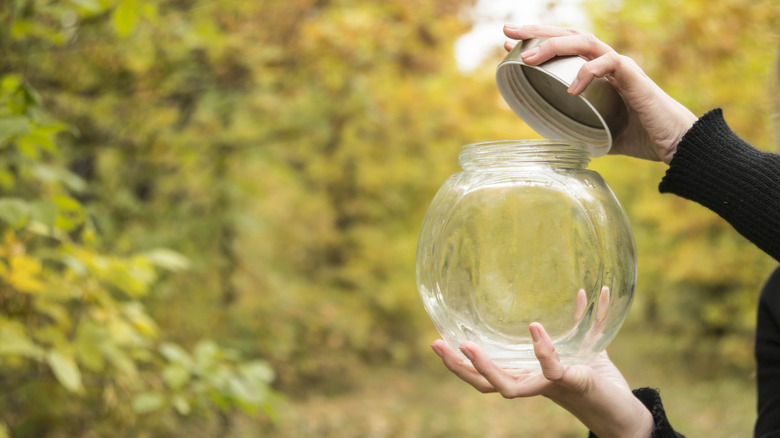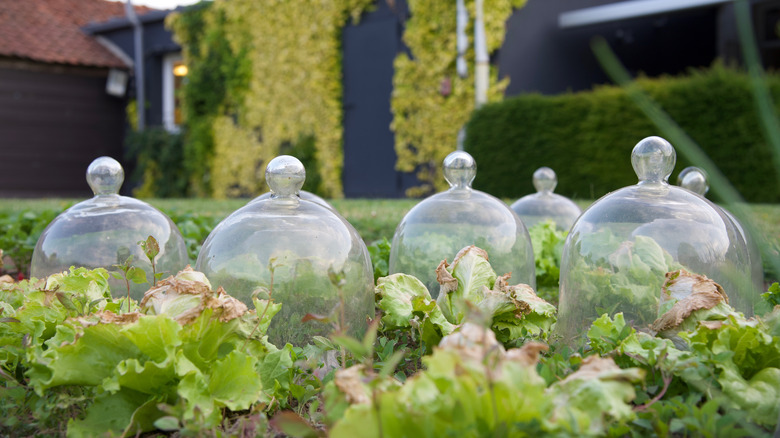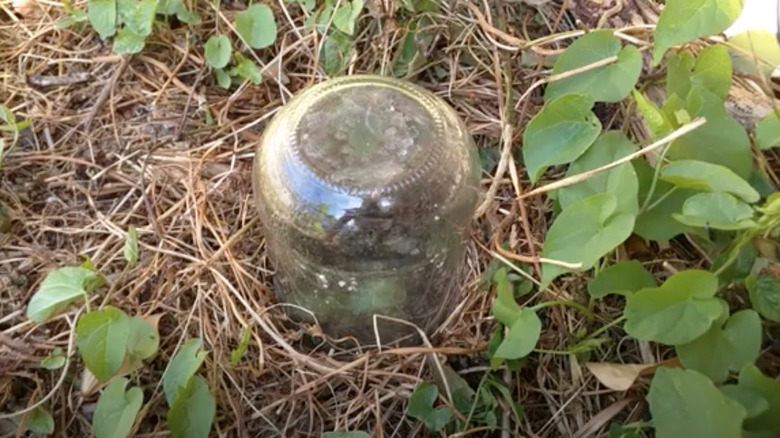Glass Jars Are The Hero Of The Garden When You Use Them Like This
After washing that thick, sturdy, crystalline glass jelly jar, it's just too hard to throw it away or recycle it. Into the kitchen cupboard it goes, joining the 20-odd other jars you've collected that year alone. Clearly, you need some genius ways to use old jars to level up your gardening game — and boy do we have the best idea! It's pretty clear that jars don't make good seed starter pots, as drilling drainage holes into the glass is decidedly tricky. But flip some glass jars upside down atop those newly planted carrot seeds or petunia seedlings and you have yourself a really useful (and free!) growing tool. Glass jars protect your delicate sprouts from cold, rain, wind, and things that are out to eat them, giving them a fighting chance at maturity — and doing their job of producing abundant blooms or delicious dinner ingredients.
The idea is inspired by a traditional gardening tool called a cloche or bell jar, so-called because it resembles its ear-splitting namesake. However, they're un-strikeable bells since they're made from transparent blown glass. Cloches work just like a greenhouse for individual plants. Sunlight, or more aptly solar radiation, penetrates the glass walls, warming the air inside and aiding transpiration. Evidence for cloches dates back to at least the 1600s, and Thomas Jefferson was also enamored by the contraption. Find out how to use glass jars as a modern version of this gardening tool.
Glass jars outshine plastic when it comes to seedling protection
Today, you can buy vintage and new cloches, though legitimate glass designs tend to be on the pricier side and hard to find. For example, one medium-sized glass bell jar sells for just shy of $70 at The Shops at Colonial Williamsburg. For budget-conscious gardeners, an upturned glass jar serves the same purpose — that is, it creates a protective pocket full of warm, moist air between the seedling and the temperamental outside world — and is cheap or, even better, completely free. Sure, plastic bottles can be used to protect young plants in your garden, but you could also argue the case that upcycled glass jars are the superior option. Unlike plastic bottles, there's no cutting necessary with glass jars. Simply unscrew the lid and pop the jar over the seedling.
Glass is also far sturdier than plastic: a jar won't blow over in the wind or break down under UV exposure. Gardening experts state that cloches can raise the temperature of the soil they encapsulate by up to 50 degrees Fahrenheit — helping the plant inside survive cold spring temperatures or even overwinter — and decrease seed germination times by as much as 14 days. It's not a stretch to imagine a glass jar used in the same manner as its purpose built counterpart could do the same. They also form a barrier between your seedling and hungry birds, land mollusks, and insects.
Channel your inner ancient gardener and use glass jars as cloches
However, glass jars aren't all thriving terrariums and unscalable anti-slug battlements. Without adequate ventilation, humidity levels inside the jar can get so high that moisture-loving pests and diseases thrive. The walls of a jar can act as a magnifying glass, the concentrated sunlight burning the plant inside. Jars are only useful on a small scale, since you can only cover a single plant. Plus, you need a lot of storage space; disused jars don't stack easily.
At the same time, given the many benefits and relatively few downsides, you're probably ready to turn a glass jar into a cloche. First, wash the jar thoroughly with warm soap and water and, ideally, remove the label. Whether you're transplanting seedlings from a greenhouse or nursery or direct-sowing your plants, the method is the same. Dig a small hole in the mulch around the plant or seed to expose the dirt below. Nestle the jar (sans lid) into it, gently turning it as you press down to slightly embed the rim into the soil. Your seedling or seed should be in the center of the jar. Make sure the jar you choose provides enough room for the plant to grow. If you want to further cover plants from frost or dropping temperatures, wrap the jar in an old blanket or pop a waterproof flashlight inside overnight. Prop open the jar or remove it completely on hot days — you don't want boiled veggies!


